In today’s increasingly urbanized world, millions of people find themselves living in apartments, condominiums, and homes with limited outdoor space. Yet the desire to grow plants, cultivate fresh herbs, and create beautiful green spaces remains as strong as ever. Container gardening offers the perfect solution, transforming even the smallest balconies, patios, windowsills, and indoor spaces into thriving gardens that provide beauty, fresh food, and the satisfaction of nurturing growing plants.
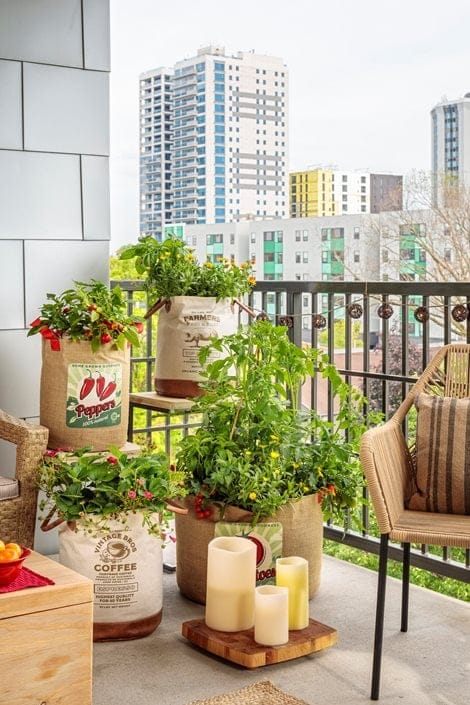
Container gardening is far more than simply placing plants in pots; it’s a sophisticated approach to gardening that maximizes limited space while creating stunning visual displays and productive growing environments. This versatile gardening method allows you to overcome many traditional gardening challenges, including poor soil conditions, limited space, rental restrictions, and physical limitations that might make traditional ground gardening difficult or impossible.
The beauty of container gardening lies in its flexibility and adaptability. Containers can be moved to follow the sun, brought indoors during harsh weather, rearranged to create new displays, and easily maintained without the back-breaking work often associated with traditional gardening. Whether you’re a complete beginner looking to grow your first herbs on a kitchen windowsill or an experienced gardener seeking to maximize production in a small urban space, container gardening offers endless possibilities for creativity and success.
This comprehensive guide will walk you through every aspect of successful container gardening, from selecting the right containers and understanding soil requirements to choosing appropriate plants and mastering watering techniques. You’ll discover how to create stunning displays that provide year-round interest, grow fresh food in the smallest spaces, and develop the skills needed to maintain thriving container gardens regardless of your living situation or experience level.
Understanding Container Gardening Fundamentals
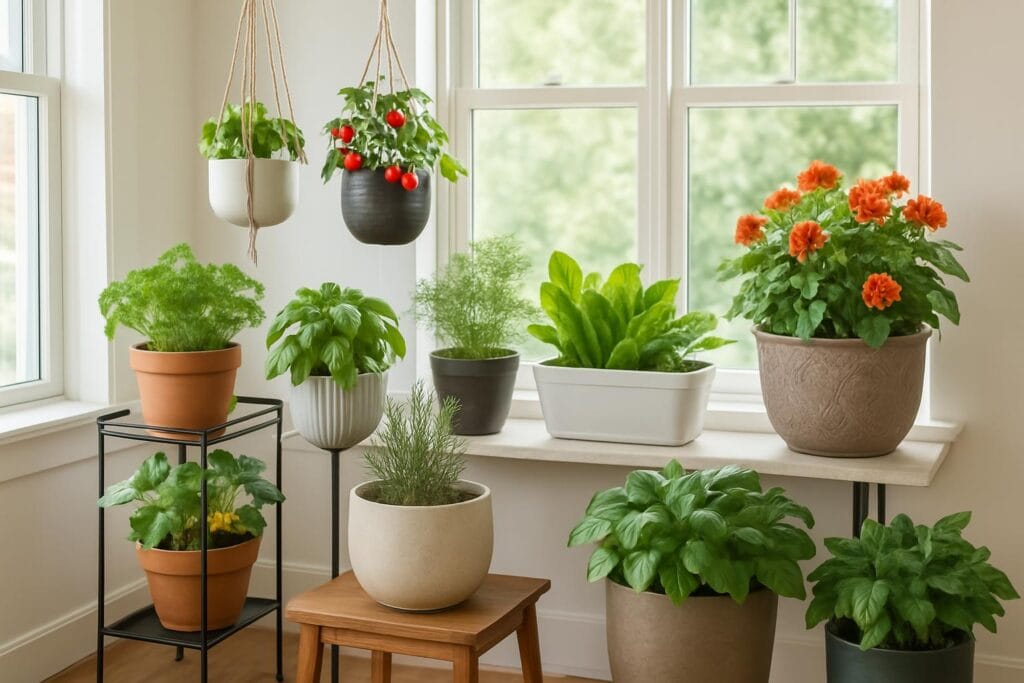
Container gardening operates on different principles than traditional ground gardening, and understanding these fundamentals is crucial for success. Plants grown in containers face unique challenges and opportunities that require specific approaches to soil, water, nutrients, and environmental management. The confined root space, altered drainage patterns, and increased exposure to temperature fluctuations all influence how plants grow and what they need to thrive.
The Container Environment:
When plants grow in containers, their root systems are confined to a much smaller space than they would occupy in the ground. This limitation affects every aspect of plant growth, from nutrient uptake and water absorption to root development and overall plant size. Understanding these constraints allows you to work with them rather than against them, creating optimal growing conditions within the confined space.
Container plants are more dependent on their caretakers than ground-planted specimens because they cannot extend their roots to seek water and nutrients beyond the container boundaries. This dependency means that container gardening requires more attention to watering, fertilizing, and monitoring plant health, but it also provides greater control over growing conditions and the ability to provide exactly what each plant needs.
The soil in containers behaves differently than garden soil, warming up faster in spring, drying out more quickly during hot weather, and potentially freezing more readily in winter. These temperature fluctuations can be both advantageous and challenging, allowing for earlier spring planting and extended growing seasons while also requiring protection during extreme weather conditions.
Space Optimization Principles:
Successful container gardening maximizes the productive potential of every square inch of available space. This optimization involves thinking vertically as well as horizontally, utilizing walls, railings, and overhead spaces to create multi-level growing environments. Vertical gardening techniques can multiply your growing space several times over, allowing you to cultivate far more plants than would be possible with traditional horizontal arrangements.
Consider the mature size of plants when planning container arrangements, ensuring that each plant has adequate space to develop while making efficient use of available area. Companion planting principles apply to container gardening just as they do to traditional gardens, allowing you to grow compatible plants together in larger containers or arrange containers to create beneficial plant communities.
The mobility of containers is one of their greatest advantages, allowing you to move plants to optimal locations as seasons change, light conditions shift, or plant needs evolve. This flexibility enables you to provide ideal growing conditions for different plants throughout the year and to create dynamic displays that can be rearranged for aesthetic or practical purposes.
Environmental Considerations:
Container gardens exist in unique microclimates that can be quite different from the surrounding environment. Containers on concrete surfaces may experience reflected heat that increases temperatures, while containers in windy locations may dry out more quickly and require wind protection. Understanding these microclimate effects allows you to select appropriate plants and adjust care routines accordingly.
Light conditions in small spaces can be challenging, with buildings, overhangs, and other structures creating complex patterns of sun and shade throughout the day. Careful observation of light patterns in your space will help you position containers optimally and select plants that will thrive in the available conditions. Remember that light conditions can change seasonally as the sun’s angle shifts and deciduous trees leaf out or drop their leaves.
Wind exposure is often more significant for container plants than for ground-planted specimens, as containers elevate plants into air currents and provide less wind protection. Strong winds can quickly dry out container soil and damage plant foliage, making wind protection an important consideration in exposed locations.
Choosing the Right Containers
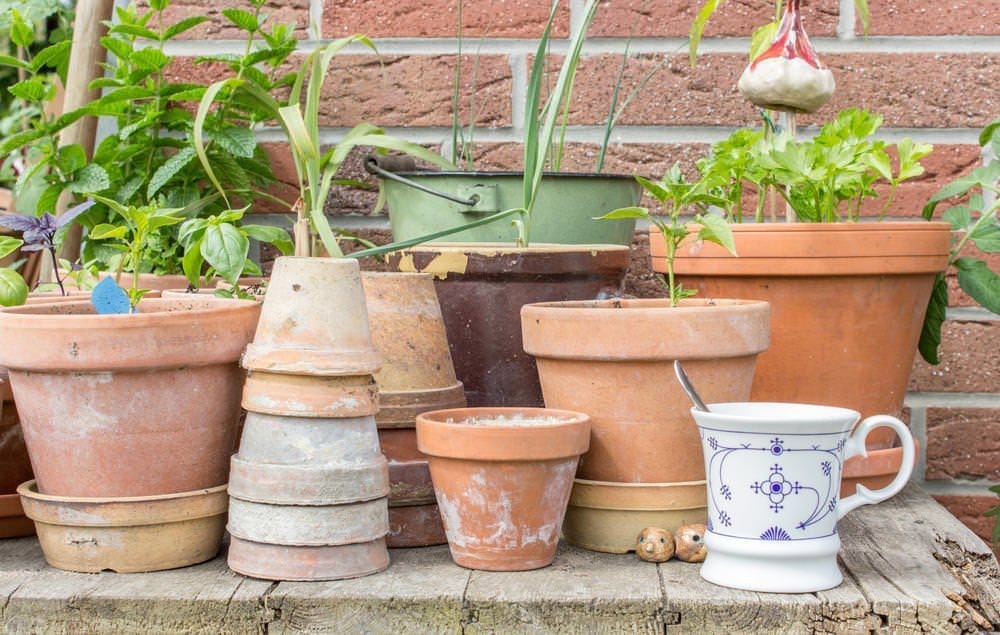
The container you choose for your plants is far more than just a decorative element; it’s a critical component that directly affects plant health, growth, and long-term success. The right container provides adequate space for root development, proper drainage, appropriate insulation, and aesthetic appeal that enhances your overall garden design. Understanding the characteristics of different container materials, sizes, and styles will help you make informed decisions that support both plant health and your design goals.
Container Materials and Their Properties:
Terracotta and clay pots are among the most traditional and popular choices for container gardening, offering excellent breathability that allows air to reach plant roots and excess moisture to evaporate through the pot walls. This natural moisture regulation can be beneficial for plants that prefer well-draining conditions, but it also means that clay pots dry out more quickly than non-porous alternatives, requiring more frequent watering during hot weather.
The weight of terracotta pots provides stability for tall or top-heavy plants, but this same weight can make them difficult to move and potentially problematic for balconies or structures with weight limitations. Clay pots are also susceptible to cracking in freezing temperatures, making them less suitable for year-round outdoor use in cold climates unless they’re moved to protected locations during winter.
Plastic containers offer lightweight, affordable, and durable alternatives that retain moisture more effectively than clay pots. Modern plastic containers come in a wide variety of colors, textures, and styles that can mimic more expensive materials while providing excellent functionality. The non-porous nature of plastic means that watering frequency can be reduced, but it also requires more attention to drainage to prevent waterlogged soil conditions.
Fiberglass and resin containers combine the aesthetic appeal of natural materials with the practical benefits of synthetic construction. These containers are lightweight, weather-resistant, and available in sophisticated designs that complement any garden style. While initially more expensive than basic plastic pots, quality fiberglass containers can last for many years and provide excellent growing conditions for plants.
Metal containers, including galvanized steel, aluminum, and decorative metals, offer modern aesthetic appeal and excellent durability. However, metal containers can heat up significantly in direct sunlight, potentially damaging plant roots, and may require insulation or careful placement to prevent overheating. Drainage is particularly important in metal containers, as they don’t provide the natural moisture regulation of porous materials.
Size and Proportion Considerations:
Container size directly affects plant health and growth potential, with larger containers generally providing better growing conditions than smaller ones. Larger containers hold more soil, which provides greater nutrient reserves, more stable moisture levels, and more room for root development. They also have greater thermal mass, which helps moderate temperature fluctuations that can stress plants.
The relationship between container size and plant size should be carefully considered, with containers providing adequate room for root development while not being so large that soil stays waterlogged around small root systems. As a general rule, containers should be at least as wide as they are deep, and deep-rooted plants require containers with adequate depth for proper root development.
Consider the mature size of plants when selecting containers, allowing room for growth while avoiding containers that are so large they overwhelm young plants. Many successful container gardeners start with appropriately sized containers and repot plants into larger containers as they grow, rather than starting with oversized containers that can lead to watering and soil health problems.
Drainage and Structural Features:
Proper drainage is absolutely critical for container gardening success, as waterlogged soil is one of the most common causes of plant failure in containers. All containers must have drainage holes that allow excess water to escape, preventing the anaerobic soil conditions that lead to root rot and plant death. The size and number of drainage holes should be proportional to the container size, with larger containers requiring multiple drainage holes.
Consider containers with built-in water reservoirs or self-watering features for plants that require consistent moisture or for situations where regular watering may be challenging. These systems can help maintain optimal soil moisture levels while preventing both drought stress and waterlogging, though they require understanding of how the system works and appropriate plant selection.
The shape of containers affects both plant growth and aesthetic appeal, with different shapes being more suitable for different types of plants. Wide, shallow containers work well for spreading plants and multiple plantings, while tall, narrow containers are ideal for deep-rooted plants or dramatic vertical displays. Consider how container shape will affect soil volume, drainage, and the overall proportions of your garden design.
Soil Mixes and Growing Media
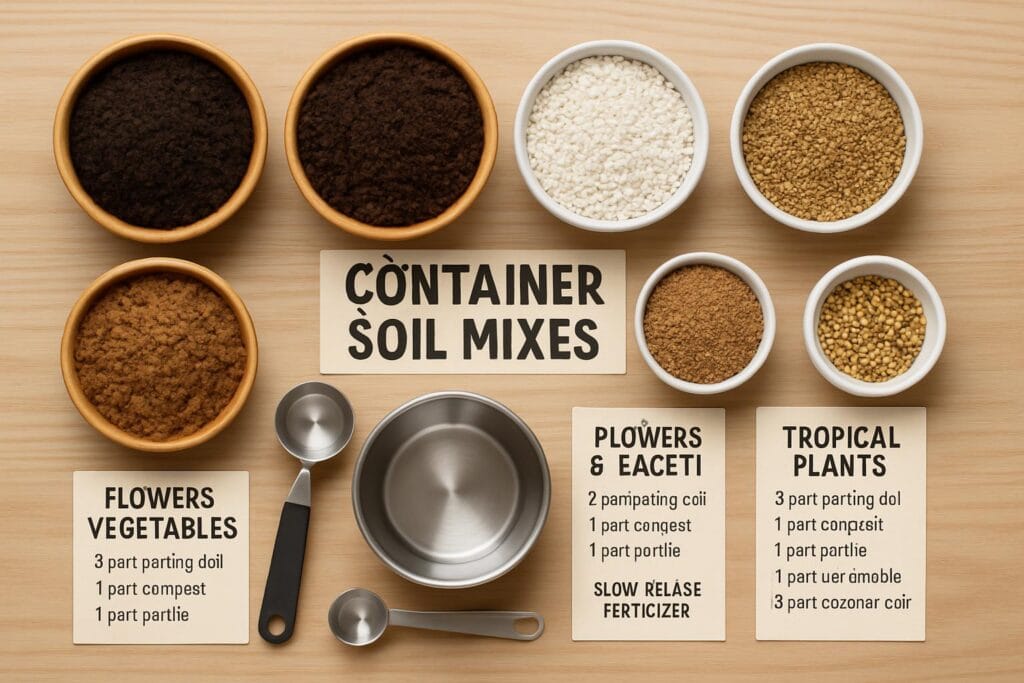
The growing medium you choose for your containers is perhaps the most critical factor in determining plant success, as it provides the foundation for root development, nutrient availability, water retention, and overall plant health. Container growing media must perform multiple functions simultaneously: supporting plant roots, retaining adequate moisture while allowing excess water to drain, providing essential nutrients, and maintaining proper aeration for healthy root development.
Understanding Container Soil Requirements:
Container soils face unique challenges that don’t exist in ground gardening situations. The confined space means that soil cannot be replenished naturally through earthworm activity, organic matter decomposition, and nutrient cycling that occurs in garden beds. Container soils must be carefully formulated to provide optimal growing conditions from the start and maintain those conditions throughout the growing season.
Regular garden soil is generally unsuitable for container use because it becomes too dense when confined in pots, leading to poor drainage and inadequate aeration. Garden soil may also contain pests, diseases, and weed seeds that can cause problems in the controlled environment of containers. Instead, container gardening requires specially formulated growing media that provide the right balance of drainage, water retention, and nutrient availability.
The ideal container growing medium should drain freely while retaining adequate moisture for plant roots, provide good aeration to prevent root rot, contain appropriate nutrients for plant growth, and maintain its structure throughout the growing season without becoming compacted or breaking down excessively. Achieving this balance requires understanding the properties of different soil components and how they work together.
Commercial Potting Mix Options:
High-quality commercial potting mixes are formulated specifically for container growing and provide a convenient, reliable foundation for most container gardening applications. These mixes typically contain a blend of peat moss or coconut coir, vermiculite or perlite for drainage and aeration, and composted organic matter for nutrients and soil structure. Many also include slow-release fertilizers and beneficial microorganisms.
When selecting commercial potting mixes, look for products that are specifically labeled for container use rather than general-purpose soil amendments. Quality mixes should feel light and fluffy, drain well while retaining moisture, and have a pleasant, earthy smell without any sour or ammonia-like odors that might indicate poor composting or contamination.
Different plants may benefit from specialized potting mixes formulated for their specific needs. Cacti and succulents require fast-draining mixes with excellent aeration, while moisture-loving plants may benefit from mixes with higher water retention. Acid-loving plants like blueberries and azaleas need acidic potting mixes, while herbs and vegetables generally prefer neutral to slightly alkaline conditions.
Creating Custom Soil Blends:
Many experienced container gardeners prefer to create their own soil blends, allowing them to customize the growing medium for specific plants and growing conditions. A basic container mix might consist of equal parts high-quality compost, peat moss or coconut coir, and perlite or vermiculite, with adjustments made based on plant requirements and local conditions.
Compost provides essential nutrients and beneficial microorganisms while improving soil structure and water retention. Use only well-aged, fully decomposed compost to avoid burning plant roots or introducing pathogens. The compost should have a dark, crumbly texture and pleasant earthy smell without any recognizable organic matter remaining.
Peat moss has excellent water retention properties and helps create the slightly acidic conditions preferred by many plants, but it can be difficult to rewet once it dries out completely. Coconut coir provides similar benefits with better rewetting characteristics and is considered more environmentally sustainable than peat moss harvesting.
Perlite and vermiculite both improve drainage and aeration in container mixes, but they have different properties. Perlite is lightweight and provides excellent drainage, making it ideal for plants that prefer drier conditions. Vermiculite retains more moisture and nutrients, making it better for plants that need consistent moisture levels.
Soil Amendments and Enhancements:
Various amendments can be added to container mixes to improve their performance for specific plants or growing conditions. Slow-release fertilizers provide consistent nutrient availability throughout the growing season, reducing the need for frequent liquid fertilizing. Choose fertilizers with nutrient ratios appropriate for your plants, with higher nitrogen for leafy greens and higher phosphorus and potassium for flowering and fruiting plants.
Beneficial microorganisms, including mycorrhizal fungi and beneficial bacteria, can significantly improve plant health and nutrient uptake in container environments. These organisms form symbiotic relationships with plant roots, extending the effective root zone and improving the plant’s ability to access nutrients and water from the growing medium.
Water-retaining crystals or gels can help maintain consistent soil moisture in containers, particularly useful for plants that require steady moisture or in situations where regular watering may be challenging. However, these products should be used sparingly and according to manufacturer directions, as excessive use can lead to waterlogged conditions.
Plant Selection for Container Success
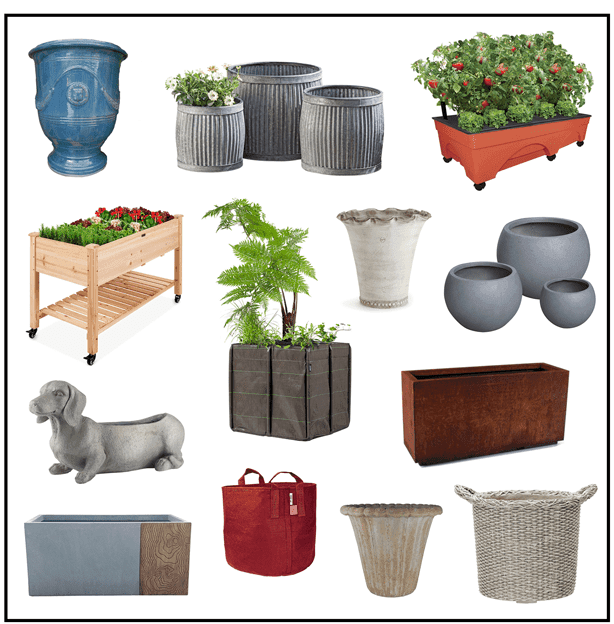
Choosing the right plants for container growing is crucial for creating successful, thriving gardens in small spaces. While many plants can be grown in containers, some are naturally better suited to the unique conditions of container life, including confined root space, variable moisture levels, and exposure to temperature fluctuations. Understanding plant characteristics and matching them to container conditions will help you create beautiful, productive gardens that thrive throughout the growing season.
Characteristics of Container-Friendly Plants:
Plants that excel in containers typically have compact growth habits, efficient root systems, and tolerance for the variable conditions that container growing presents. Dwarf and compact varieties of larger plants often perform better in containers than their full-sized counterparts, providing the same ornamental or productive value while requiring less space and resources.
Plants with fibrous root systems generally adapt better to container growing than those with deep taproots, as fibrous roots can efficiently utilize the available soil volume in containers. However, many taproot plants can still be grown successfully in containers if provided with adequate depth and appropriate care.
Consider the mature size of plants when making selections, ensuring that they will be proportionate to their containers and your available space. Plants that naturally stay compact or can be maintained at a desired size through pruning are ideal for container growing, while plants that require extensive space for proper development may be challenging in confined spaces.
Vegetables and Herbs for Containers:
Container vegetable gardening allows you to grow fresh, flavorful produce even in the smallest spaces, providing the satisfaction of homegrown food and the convenience of having herbs and vegetables close at hand. Many vegetables are well-suited to container growing, particularly compact varieties that have been specifically bred for small-space gardening.
Leafy greens like lettuce, spinach, kale, and Asian greens are excellent choices for container growing, as they have shallow root systems, mature quickly, and can be harvested continuously throughout the growing season. These crops can be grown in relatively small containers and provide fresh salads and cooking greens with minimal space requirements.
Herbs are perhaps the most rewarding plants for beginning container gardeners, as they’re generally easy to grow, require minimal space, and provide immediate culinary benefits. Basil, parsley, cilantro, chives, and oregano all thrive in containers and can be harvested regularly to encourage continued growth. Many herbs also provide attractive foliage and flowers that enhance the ornamental value of container displays.
Compact fruiting vegetables like cherry tomatoes, peppers, and eggplants can be very productive in containers when provided with adequate space and support. Choose determinate or dwarf varieties that are specifically recommended for container growing, and provide sturdy support structures for plants that will bear heavy fruit loads.
Flowering Plants and Ornamentals:
Flowering plants bring color, fragrance, and visual interest to container gardens, creating beautiful displays that can be enjoyed throughout the growing season. Annual flowers are particularly well-suited to container growing, as they provide continuous blooms and can be easily replaced or rearranged as seasons change.
Petunias, marigolds, impatiens, and begonias are classic container flowers that provide reliable color and are relatively easy to grow. These plants are available in a wide range of colors and forms, allowing you to create coordinated displays or dramatic contrasts depending on your aesthetic preferences.
Perennial flowers can provide long-term value in container gardens, returning year after year with proper care and winter protection. Choose perennials that are hardy in your climate and suitable for container growing, such as daylilies, hostas, and ornamental grasses. Keep in mind that perennial containers may need winter protection in cold climates.
Consider plants with interesting foliage as well as flowers, as foliage provides structure and interest even when plants aren’t blooming. Coleus, caladiums, and ornamental sweet potato vines offer dramatic foliage colors and textures that can serve as focal points or complement flowering plants in mixed containers.
Specialty Plants and Unique Options:
Succulents and cacti are excellent choices for container gardening, particularly in sunny locations or for gardeners who prefer low-maintenance plants. These plants store water in their tissues, making them drought-tolerant and forgiving of irregular watering. They also offer unique forms, textures, and colors that can create striking container displays.
Dwarf fruit trees and berry bushes can provide both ornamental value and edible harvests in larger containers. Dwarf citrus trees, compact apple varieties, and berry bushes like blueberries and strawberries can be productive in containers while adding structure and seasonal interest to your garden.
Tropical and exotic plants can be grown in containers in temperate climates, allowing you to enjoy plants that wouldn’t survive local winters. These containers can be moved indoors during cold weather, extending the growing season and providing indoor interest during winter months.
Watering Strategies and Techniques
Container plants have unique watering needs that differ significantly from ground-planted specimens, requiring more frequent attention and different techniques to maintain optimal soil moisture levels. The confined root space, increased exposure to drying conditions, and variable drainage characteristics of different containers all influence how often and how much water plants need. Developing effective watering strategies is essential for container gardening success and can mean the difference between thriving plants and disappointing failures.
Understanding Container Water Dynamics:
Water behaves differently in containers than in garden beds, with faster drying rates, more dramatic moisture fluctuations, and greater dependence on external water sources. Container soil can dry out completely in hot, windy conditions, while the same soil might stay waterlogged during cool, humid weather. Understanding these dynamics helps you adjust watering practices to match changing conditions.
The size and material of containers significantly affect watering requirements, with smaller containers drying out faster than larger ones and porous materials like terracotta allowing more moisture evaporation than non-porous plastic or glazed ceramic. Dark-colored containers absorb more heat and may require more frequent watering than light-colored alternatives.
Plant size and growth stage also influence watering needs, with larger plants requiring more water than smaller ones and actively growing plants needing more moisture than dormant specimens. Newly planted containers may need different watering schedules than established plantings, as root systems develop and plants adapt to their container environment.
Developing Effective Watering Routines:
Consistent watering schedules help maintain optimal soil moisture levels while preventing the stress that comes from dramatic moisture fluctuations. However, rigid schedules must be balanced with flexibility to account for changing weather conditions, seasonal variations, and plant development stages.
Check soil moisture regularly by inserting your finger into the soil or using a moisture meter to determine when watering is needed. Most container plants benefit from watering when the top inch of soil feels dry, though some plants prefer consistently moist conditions while others tolerate drier periods between waterings.
Water thoroughly when you do water, ensuring that water reaches all parts of the root zone and excess water drains from the bottom of containers. Shallow, frequent watering encourages shallow root development and makes plants more susceptible to drought stress, while deep, less frequent watering promotes deeper root growth and greater drought tolerance.
Watering Techniques and Tools:
Hand watering with a watering can or hose allows for precise control and the opportunity to observe plant health during each watering session. Use a watering wand or nozzle that provides gentle water flow to avoid disturbing soil or damaging delicate plants. Water at the soil level rather than over plant foliage to reduce disease problems and water waste.
Drip irrigation systems can provide efficient, consistent watering for larger container gardens or when regular hand watering isn’t practical. These systems deliver water directly to the root zone with minimal waste and can be automated with timers for consistent care even when you’re away.
Self-watering containers and water reservoir systems can help maintain consistent soil moisture levels while reducing watering frequency. These systems work well for plants that prefer steady moisture and can be particularly useful for vacation care or busy schedules.
Mulching container surfaces helps retain soil moisture, reduce evaporation, and moderate soil temperature fluctuations. Use organic mulches like shredded bark or compost, or decorative mulches like gravel or decorative stones that complement your container design.
Maximizing Small Spaces with Vertical Growing
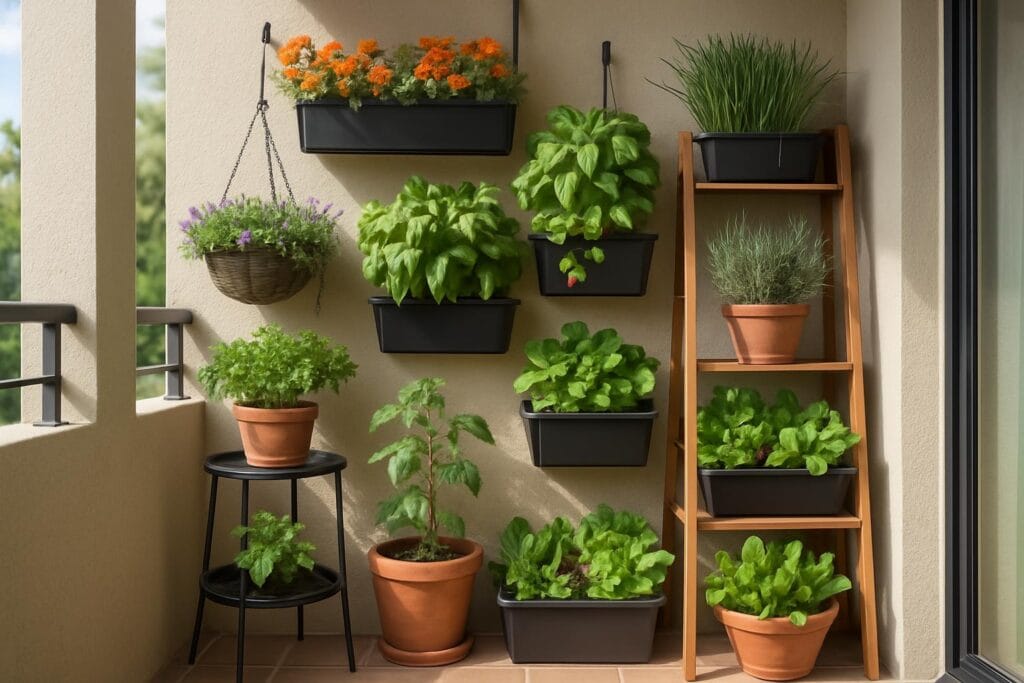
Vertical growing techniques can dramatically increase the productive capacity of small spaces, allowing you to cultivate many more plants than would be possible with traditional horizontal arrangements. By utilizing walls, railings, overhead spaces, and creative support structures, you can create lush, productive gardens even in the most confined areas. Vertical container gardening requires understanding how to support plants at different levels, manage watering and drainage in vertical systems, and select plants that thrive in elevated growing conditions.
Vertical Growing Systems and Structures:
Wall-mounted planters and pocket gardens make efficient use of vertical wall space while creating attractive living walls that can serve as privacy screens or decorative focal points. These systems range from simple individual wall-mounted containers to sophisticated modular systems that can cover entire walls with growing plants.
Tiered plant stands and ladder-style shelving create multiple growing levels within a small footprint, allowing you to display numerous containers at different heights. These structures can be purchased ready-made or constructed from simple materials, and they provide excellent access to plants for maintenance and harvesting.
Hanging baskets and suspended containers utilize overhead space that would otherwise be unused, creating dramatic displays while maximizing growing area. Consider the weight of fully watered containers when installing hanging systems, and ensure that support structures are adequate for the load they’ll carry.
Trellises and vertical support structures can transform climbing plants into living walls while providing support for vining vegetables and flowering plants. These structures can be freestanding or attached to walls, railings, or other existing structures, creating vertical growing opportunities for plants that naturally climb or can be trained upward.
Plant Selection for Vertical Gardens:
Trailing and cascading plants are ideal for elevated containers, creating dramatic displays that draw the eye upward while making efficient use of vertical space. Plants like trailing petunias, ivy geraniums, and sweet potato vines provide excellent coverage and visual impact when grown in hanging baskets or elevated containers.
Climbing vegetables like pole beans, peas, and cucumbers can be highly productive in vertical growing systems, providing substantial harvests from minimal floor space. These plants require sturdy support structures but can produce impressive yields when grown vertically.
Compact, upright plants work well in tiered systems where multiple containers are arranged at different levels. Herbs, small vegetables, and compact flowering plants can create lush displays without overwhelming their neighbors or requiring excessive space.
Consider the mature size and growth habits of plants when planning vertical arrangements, ensuring that upper-level plants don’t shade lower ones excessively and that all plants have adequate space for healthy development.
Managing Vertical Garden Systems:
Watering vertical gardens requires special attention, as water naturally flows downward and can create uneven moisture distribution throughout the system. Upper containers may dry out more quickly due to increased air circulation and heat exposure, while lower containers might receive excess water from drainage above.
Install drip trays or saucers under containers to protect surfaces and prevent water damage, particularly important for indoor vertical gardens or systems installed on decks and patios. Consider the drainage patterns of your vertical system and plan accordingly to prevent water damage to structures or neighboring plants.
Access for maintenance, harvesting, and plant care should be considered when designing vertical systems. Ensure that all plants can be reached safely for watering, pruning, and harvesting, and consider using lightweight containers and tools that are easy to handle at height.
Wind exposure increases with elevation, so vertical gardens may require wind protection or selection of plants that tolerate windy conditions. Secure all containers and support structures adequately to prevent damage during storms or high winds.
Seasonal Care and Maintenance
Successful container gardening requires understanding how seasonal changes affect plant needs and adjusting care routines accordingly. Container plants are more sensitive to seasonal variations than ground-planted specimens, experiencing greater temperature fluctuations, faster moisture changes, and increased exposure to weather extremes. Developing seasonal care strategies helps ensure that your container gardens remain healthy and productive throughout the year while preparing plants for successful transitions between seasons.
Spring Preparation and Planting:
Spring marks the beginning of the active growing season for most container gardens, requiring preparation of containers, soil refresh or replacement, and careful timing of new plantings. Begin by cleaning and inspecting containers from the previous season, checking for damage, cleaning off salt deposits or algae growth, and ensuring that drainage holes remain clear.
Refresh or replace growing media in containers, as soil nutrients become depleted over time and soil structure may deteriorate. Completely replace soil in containers that showed signs of disease problems the previous season, while containers with healthy plants may only need soil amendment with fresh compost or slow-release fertilizer.
Time spring plantings according to your local climate and the specific requirements of different plants. Cool-season crops can often be planted earlier than warm-season varieties, allowing you to extend your growing season and maximize productivity. Monitor weather forecasts and be prepared to protect tender plants from unexpected late frosts.
Summer Maintenance and Care:
Summer brings peak growing conditions for most container plants but also presents challenges from heat stress, increased water needs, and pest pressure. Develop consistent watering routines that account for increased evaporation rates and higher plant water consumption during hot weather.
Monitor plants closely for signs of heat stress, including wilting during the hottest part of the day, leaf scorch, or reduced flowering. Provide shade during extreme heat, move containers to cooler locations if possible, or use shade cloth to reduce heat stress on sensitive plants.
Fertilize regularly during the active growing season, as frequent watering leaches nutrients from container soil more quickly than from garden beds. Use liquid fertilizers for quick nutrient availability or supplement slow-release fertilizers with periodic liquid feeding during peak growth periods.
Deadhead flowers regularly to encourage continued blooming, harvest vegetables and herbs frequently to promote continued production, and prune plants as needed to maintain desired size and shape. Regular maintenance during summer keeps plants healthy and productive while preventing small problems from becoming major issues.
Fall Transition and Winter Preparation:
Fall preparation involves transitioning plants from active growth to dormancy while protecting tender specimens from cold damage. Begin reducing watering frequency as temperatures cool and plant growth slows, but continue monitoring soil moisture to prevent drought stress during warm fall weather.
Harvest remaining crops before frost damage occurs, and consider succession plantings of cool-season crops that can extend your harvest into winter. Many herbs and leafy greens can continue producing well into fall and winter with appropriate protection.
Prepare tender plants for winter by gradually reducing fertilization, allowing plants to slow their growth naturally, and planning protection strategies for plants that will remain outdoors. Move tender containers to protected locations, wrap containers for insulation, or plan to bring plants indoors for winter protection.
Clean up fallen leaves and debris that can harbor pests and diseases over winter, and consider applying dormant season treatments to prevent pest and disease problems in the following season.
Year-Round Indoor Growing:
Indoor container gardening allows you to continue growing plants throughout winter while providing fresh herbs and vegetables during the coldest months. Choose plants that adapt well to indoor conditions, including herbs, leafy greens, and compact vegetables that don’t require extensive space or intense lighting.
Provide adequate lighting for indoor plants, as natural winter light is often insufficient for healthy plant growth. Supplemental grow lights can extend day length and provide the light intensity needed for productive indoor growing.
Adjust watering and fertilizing routines for indoor conditions, as plants typically grow more slowly indoors and require less water and nutrients than during outdoor growing seasons. Monitor humidity levels and provide adequate air circulation to prevent fungal problems in the indoor environment.
Frequently Asked Questions
What size containers do I need for different types of plants?
Container size depends on the plant’s root system and mature size. Herbs and small flowers can thrive in 6-8 inch pots, while vegetables like tomatoes need at least 5-gallon containers. Leafy greens work well in shallow, wide containers (6-8 inches deep), while root vegetables require deeper containers (12+ inches). As a general rule, choose containers that are at least as wide as they are deep, and remember that larger containers provide more stable growing conditions.
How often should I water my container plants?
Watering frequency depends on container size, plant type, weather conditions, and container material. Check soil moisture daily by inserting your finger 1-2 inches into the soil. Most plants need watering when the top inch feels dry. Small containers may need daily watering in hot weather, while larger containers might need watering every 2-3 days. Establish a routine but remain flexible based on weather and plant needs.
Can I use regular garden soil in containers?
No, regular garden soil is too heavy and doesn’t drain well in containers, leading to waterlogged conditions and root rot. Use commercial potting mix designed for containers, or create your own blend with compost, peat moss or coconut coir, and perlite or vermiculite. Container soil needs to be lighter and more porous than garden soil to provide proper drainage and aeration.
Can I use regular garden soil in containers?
No, regular garden soil is too heavy and doesn’t drain well in containers, leading to waterlogged conditions and root rot. Use commercial potting mix designed for containers, or create your own blend with compost, peat moss or coconut coir, and perlite or vermiculite. Container soil needs to be lighter and more porous than garden soil to provide proper drainage and aeration.
What vegetables grow best in containers?
Many vegetables excel in containers, including leafy greens (lettuce, spinach, kale), herbs (basil, parsley, cilantro), compact tomatoes, peppers, radishes, carrots, and beans. Choose dwarf or compact varieties when available, and ensure containers are large enough for the plant’s root system. Avoid large vegetables like corn or winter squash unless you have very large containers.
How do I prevent my containers from drying out too quickly?
Use larger containers when possible, as they hold more soil and dry out slower. Add water-retaining materials like coconut coir to your soil mix, mulch the soil surface, group containers together to create humidity, and consider self-watering containers for plants that need consistent moisture. Place containers in locations that receive some protection from hot afternoon sun and drying winds.
What’s the best way to fertilize container plants?
Container plants need regular fertilization since nutrients wash out with frequent watering. Use slow-release fertilizer mixed into the soil at planting, supplemented with liquid fertilizer every 2-4 weeks during the growing season. Organic options include compost, fish emulsion, and kelp meal. Adjust fertilizer type based on plant needs – higher nitrogen for leafy plants, balanced fertilizer for flowers and vegetables.
Can I grow plants indoors year-round?
Yes, many plants thrive indoors with proper care. Herbs, leafy greens, and some compact vegetables work well indoors. Provide adequate light (south-facing windows or grow lights), maintain appropriate humidity, ensure good air circulation, and adjust watering for slower indoor growth. Choose compact varieties and be prepared to hand-pollinate fruiting plants if needed.
How do I protect container plants in winter?
Protection methods depend on your climate and plant hardiness. Move tender plants indoors, wrap containers with insulation to prevent root freezing, group containers together for protection, or move them to sheltered locations like unheated garages. In mild climates, many containers can remain outdoors with minimal protection. Reduce watering and stop fertilizing as plants enter dormancy.
What’s the best way to arrange containers for maximum visual impact?
Create visual interest by varying container heights, sizes, and shapes. Use odd numbers of containers, place larger containers in back with smaller ones in front, and include trailing plants to soften edges. Consider color coordination between containers and plants, create focal points with specimen plants, and use vertical elements like trellises or plant stands to add dimension.
How do I deal with pests in container gardens?
Prevent pest problems by choosing healthy plants, providing proper care, and maintaining good garden hygiene. Inspect plants regularly for early pest detection, encourage beneficial insects with diverse plantings, and use organic pest control methods like insecticidal soap or neem oil when needed. Isolate new plants before adding them to your garden, and remove affected plants promptly to prevent pest spread.
Can I reuse potting soil from year to year?
Potting soil can be refreshed and reused if plants were healthy, but complete replacement is recommended if there were disease problems. Refresh old soil by mixing in fresh compost, replacing 25-50% with new potting mix, and adding slow-release fertilizer. Remove old roots and debris, and consider sterilizing soil if disease was present. Fresh soil provides better nutrition and structure for new plantings.
What are the most common mistakes in container gardening?
Common mistakes include using containers without drainage holes, overwatering or underwatering, using garden soil instead of potting mix, choosing containers too small for the plants, placing sun plants in shade or vice versa, and neglecting regular fertilization. Start with easy plants, observe your plants daily, and adjust care based on plant response and changing conditions.





